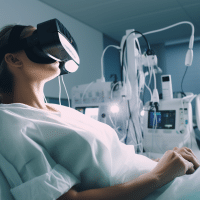The Unseen Consequences: Exploring VR Side Effects on Users

The world of virtual reality (VR) is an incredibly exciting and innovative realm, where users are transported to new and immersive worlds, allowing them to experience things beyond their wildest imagination. However, as with any new technology, it’s important to consider the potential side effects that may arise from prolonged use.
One of the potential of VR side effects is physical discomfort. Extended periods of wearing VR headsets can lead to feelings of dizziness, nausea, and eye strain. These physical sensations can be a result of the discrepancy between what the user is seeing in the virtual world and the lack of corresponding physical movement in the real world. Additionally, the weight and fit of VR headsets can also contribute to discomfort, especially if not properly adjusted or worn for extended periods of time.
Another aspect to consider is the potential psychological distress that can arise from using VR. The immersive nature of VR experiences can blur the lines between reality and virtuality, leading to a phenomenon known as “cybersickness” or virtual reality sickness. Symptoms can include disorientation, anxiety, and even panic attacks. It’s important for users to be aware of these psychological effects and take breaks when needed to maintain a healthy balance between the virtual and real world.
In this blog, we will delve deeper into the various VR side effects that users may encounter, providing insights on how to mitigate these challenges. By understanding and addressing these potential side effects, users can fully enjoy the incredible world of virtual reality while safeguarding their physical and mental well-being.
Exploring the Potential VR Side Effects
As virtual reality technology continues to advance, it is becoming increasingly accessible to the public. While this technology has the potential to revolutionize the way we interact with the world, it is important to consider the potential side effects of using virtual reality. VR side effects can range from mild discomfort to more serious physical and psychological issues.
Common physical side effects include nausea, dizziness, and headaches. These symptoms can be caused by the disconnect between the user’s physical body and the virtual environment. Additionally, users may experience psychological issues such as anxiety, fear, and confusion. These symptoms can be caused by the immersive nature of virtual reality, which can be overwhelming for some users. It is important to be aware of the potential side effects of virtual reality before using the technology.
By understanding the risks associated with virtual reality, users can make informed decisions about their use of the technology.

The Impact of Prolonged VR Use on Mental Health
The virtual reality (VR) revolution has been a game-changer for the gaming industry, allowing users to immerse themselves in a world of their own creation. With stunning graphics, realistic simulations, and interactive experiences, VR has opened up new possibilities for entertainment and exploration.
However, as with any emerging technology, there are potential side effects that users should be aware of. While the most common VR side effects are motion sickness, eye strain, and headaches, there are other factors that can have a lasting impact on users’ mental health.
One such factor is the intense graphics and rapid movements that are common in VR games. These can contribute to the onset of motion sickness, especially for individuals who are more prone to it. Additionally, prolonged use of VR can lead to feelings of anxiety, depression, and disorientation. The disconnect between the user’s physical environment and the virtual world they are experiencing can create a sense of dissociation and confusion.
To mitigate these risks, it is important for users to take steps to prioritize their well-being while enjoying VR. Taking regular breaks to rest and recalibrate, using the correct headset that fits comfortably, and limiting the amount of time spent in VR can all help to reduce the likelihood of experiencing negative side effects.
By being aware of the potential risks and taking proactive measures, users can continue to enjoy the immersive world of VR while safeguarding their mental and physical well-being.
The Physical Effects of VR on the Human Body
The virtual reality (VR) revolution is here, and it’s changing the way we interact with the world. But with this new technology comes a host of potential side effects that users should be aware of. VR side effects can range from minor discomforts to more serious physical issues.
The most common VR side effects are eye strain, headaches, and nausea. Eye strain is caused by the intense focus required to view the virtual environment, and can be exacerbated by the use of headsets. Headaches can be caused by the same intense focus, as well as the physical weight of the headset. Nausea is a common side effect of VR, and is caused by the disconnect between the user’s physical body and the virtual environment.
Other physical side effects of VR include neck and shoulder pain, as well as motion sickness. Neck and shoulder pain can be caused by the weight of the headset, as well as the unnatural posture required to use the device. Motion sickness is caused by the disconnect between the user’s physical body and the virtual environment, and can be exacerbated by the use of motion controllers. It’s important to be aware of the potential physical side effects of VR before using the technology.
Taking regular breaks, using the device in a comfortable environment, and using the device for shorter periods of time can help reduce the risk of physical side effects.
The Social Implications of VR Use
As virtual reality technology continues to advance at an unprecedented pace, it is becoming increasingly accessible and affordable to the public. This accessibility has opened up a world of possibilities, with VR poised to revolutionize the way we interact with the world around us. However, as with any emerging technology, it is crucial to consider the potential side effects that may accompany its use.
VR has been linked to a range of physical and psychological side effects, some of which can be quite pronounced. One of the most commonly reported side effects is a feeling of nausea or discomfort, often referred to as “VR sickness.” This is thought to be caused by the discrepancy between what the user sees in the virtual world and the actual physical movements they make. Additionally, prolonged use of VR can lead to feelings of dizziness and disorientation, as the brain struggles to reconcile the virtual environment with the real world.
Beyond the physical side effects, there are also psychological considerations to be aware of. Users may experience a sense of detachment from reality, as the immersive nature of VR can blur the lines between the virtual and physical worlds.
This detachment can have consequences on users’ ability to interact with the physical world, potentially leading to a decrease in social interaction as individuals become more comfortable and engrossed in the virtual realm. Moreover, the captivating and immersive nature of VR experiences can also pose a risk of addiction, as users may find themselves increasingly drawn into the virtual world, neglecting their real-life responsibilities and relationships.
Given the potential risks associated with VR use, it is crucial to approach this technology with caution and awareness. By understanding and addressing these potential side effects, we can ensure that users are able to enjoy the numerous benefits of VR without compromising their physical and mental wellbeing. This includes implementing strategies to minimize motion sickness, taking regular breaks during VR sessions, and promoting a healthy balance between virtual and real-world experiences.
In conclusion, while the potential of VR to transform our lives is undoubtedly exciting, it is vital to navigate this new frontier with a clear understanding of the potential risks involved. By doing so, we can maximize the benefits of VR technology while safeguarding the health and wellbeing of its users.
The Potential Long-Term Effects of VR
As virtual reality technology continues to advance at a rapid pace, it is becoming increasingly accessible to the public. This means that more and more people have the opportunity to experience the immersive and captivating world of VR. However, along with the excitement and potential that VR holds, it is crucial to consider the potential long-term effects of using this technology.

While using VR, it is common for users to experience some physical discomforts such as eye strain and headaches. These discomforts are often temporary and can be alleviated by taking breaks and adjusting the settings to suit individual preferences. However, it is also important to acknowledge that there can be more serious psychological issues associated with VR use.
In some cases, prolonged exposure to virtual reality can lead to feelings of anxiety and depression. This may be due to the immersive nature of the technology, which can sometimes blur the lines between the virtual world and reality. It is crucial for users to be aware of this possibility and to take steps to prioritize their mental well-being when engaging with VR experiences.
Another potential concern is the risk of a disconnect from reality. Spending extended periods of time in a virtual environment can make it challenging to distinguish between what is real and what is virtual. This can result in a feeling of isolation and detachment from the physical world. It is important for users to find a balance between virtual experiences and real-life interactions to maintain a healthy connection with reality.
Making the Leap: First VR Headset Selection and Setup
VR Roblox Adventures: Dive into the Virtual Reality Metaverse
In light of these potential risks, it is essential for users to be informed and take the necessary precautions when using VR. This includes using the technology in moderation, taking regular breaks, and being mindful of any physical or psychological discomforts that may arise. By doing so, users can fully enjoy the innovative and exciting potential of virtual reality without having to worry about the potential long-term effects on their well-being.
Conclusion
The potential of virtual reality is undeniable. It has the power to revolutionize the way we interact with the world, and it has the potential to open up new possibilities for entertainment, education, and more. But with this potential comes a certain level of risk. As we explore the possibilities of virtual reality, it is important to consider the potential side effects that may come with it. From motion sickness to eye strain, there are a number of potential VR side effects that users should be aware of.
By understanding the potential risks associated with virtual reality, users can make informed decisions about how they use the technology and how to best protect themselves.
The virtual reality revolution has been an incredibly exciting and groundbreaking development in the world of technology. The immersive and interactive experiences offered by VR have opened up a new realm of possibilities for entertainment, education, and various industries. However, as with any emerging technology, it is crucial to consider the potential side effects of prolonged VR use on both mental and physical health.
While the long-term effects of VR are still largely unknown, researchers have started exploring the impact of extended exposure to virtual environments. Some studies suggest that excessive VR use may lead to symptoms such as eye strain, dizziness, and even motion sickness. Additionally, the cognitive effects of prolonged VR immersion are being examined, including issues like dissociation and reduced spatial awareness.
Beyond the individual health concerns, it is also important to recognize the social implications of VR use. As virtual reality becomes more accessible and widespread, questions arise about its impact on social interactions and relationships. The potential for increased isolation and detachment from the real world is a valid concern that warrants attention.
To make the most of this exciting technology while safeguarding our well-being, it is crucial to be aware of the potential risks associated with VR use and take steps to mitigate them. This includes setting limits on usage time, taking regular breaks, and using VR in a well-ventilated area to minimize any discomfort. Educating users about the potential side effects and promoting responsible VR usage can help ensure that individuals can fully enjoy the benefits of virtual reality while prioritizing their health and well-being.
Ultimately, virtual reality has the potential to revolutionize the way we interact with the world and unlock incredible possibilities. However, as with any powerful tool, it is important to approach it with caution and mindfulness. By understanding the potential side effects and taking appropriate precautions, users can make informed decisions about their VR use and fully embrace the transformative experiences VR has to offer.


















